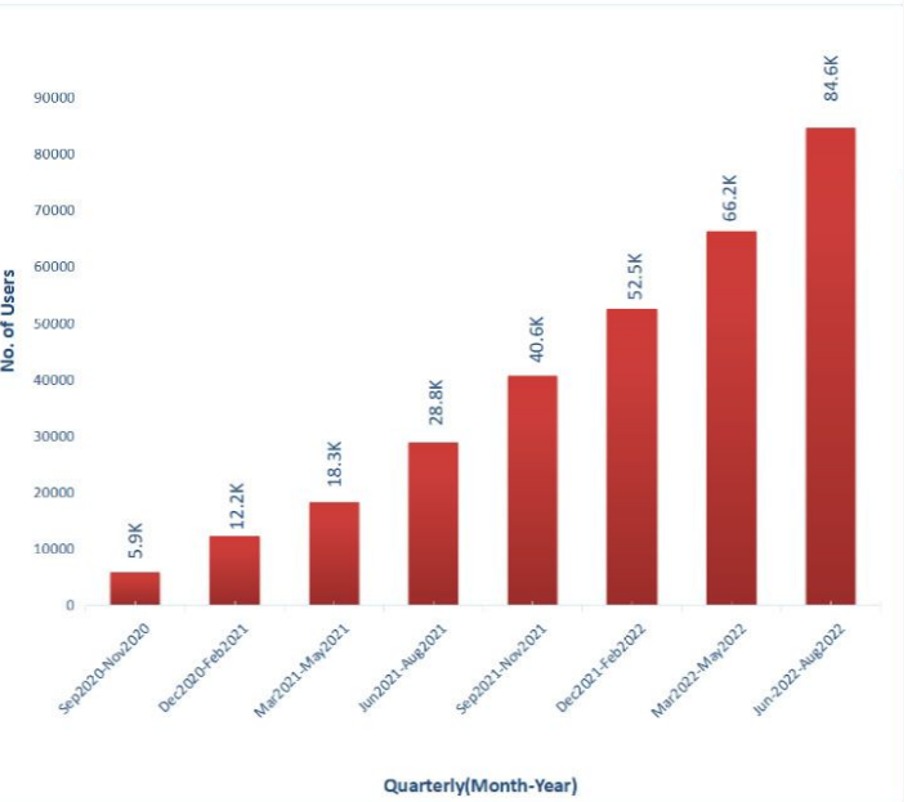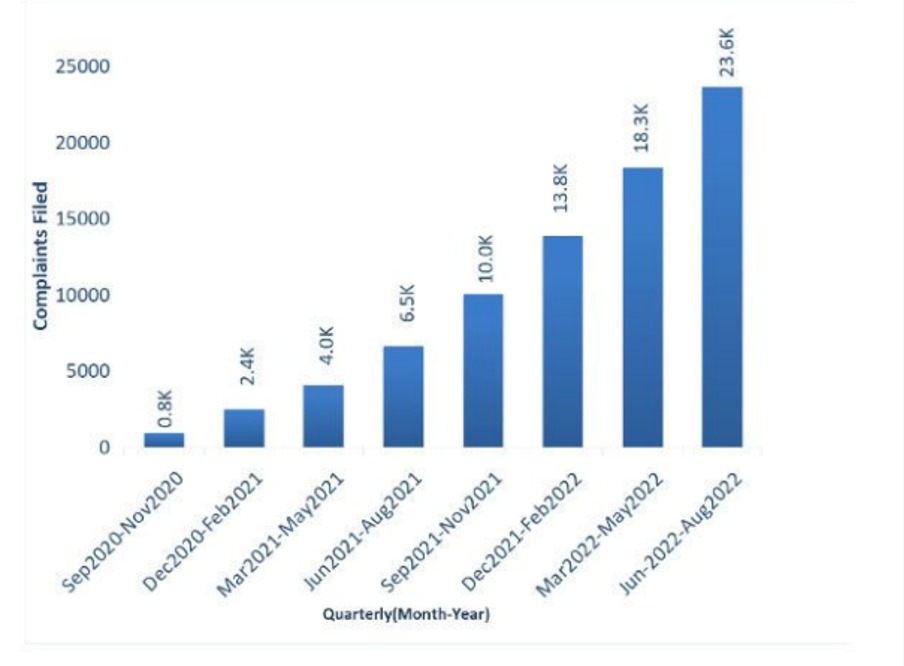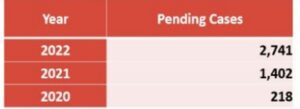The Consumer Protection Act 2019 has repealed the erstwhile Act of Consumer Protection Act 1986. During the time of Covid-19, the need was felt to provide online facilities to file complaints in the Consumer Dispute Redressal Commission. The Computerization and Computer Networking of Consumer Fora in Country (hereinafter ConfoNet) has been launched to provide transparency to the consumers. The main objective of ConfoNet is to strengthen the E-Governance through the Information Communication Technology (ICT) infrastructure at Consumer Commissions. It shall also provide operational efficiency, accessibility through transparency, and through time bound justice delivery system to consumers.
The scheme of the ConfoNet project was launched with an objective to digitalize the working of the Consumer Protection Act. It also aimed to digitalize the three tier Consumer Forums at District, State and National Level in order to empower access of information and “computerise the workflow of consumer commission.” Moreover, consumers, Consumer Activists and NGOs, Members of Consumer Courts, Bar Councils and Advocates, shall be able to file a case through an online portal as well.
Moreover, the necessary information like the number of cases filed and disposed of were not available to consumers and it was a cumbersome process to collect the authentic information. Now through the online ConfoNet project the report of the number of cases filed and disposed of can be displayed and seen by anyone on the consumer commission.
However, it could not happen until the new Act of 2019 came into existence. “It is very vital as through this portal all the deprived and aggrieved consumers will be able to file the consumer complaints in the consumer Commissions online from anywhere at the comfort of their own and also pay the complaint fee & monitor the status of the case online”[1].
Further in order to implement Confonet practically, the concept of E-Daakhil[2] has been practically implemented in 2019 Act[3]. As the CPA, 2019 has facilitated the consumers to file the complaint through online portal for which the Central Government has set up “E-Daakhil Portal”. Through this portal the consumer may approach any consumer dispute redressal commission and they need not to travel by spending money. Moreover, it shall also facilitate them to upload documents online, virtual hearing through online medium, rejoinder of parties etc. As per the report, at present, “facility of E-Daakhil is available in 544 consumer commissions, which includes the National Commission and consumer commissions in 21 states and 3 UTs. So far, more than 10,000 cases have been filed using the E-Daakhil Portal and more than 43000 users have registered on the portal[4]”. .
“The e-daakhil portal shall empower the consumer and their advocates to file the consumer complaints along with payment of requisite fees online from anywhere for the redressal of their complaints. It also facilitates the consumer commissions to scrutinize the complaints online to accept, reject or forward the complaint to the concerned commission for further processing.”
The ConfoNet portal shall display online the cause list, which may be seen by any consumer or anyone form anywhere through online. It shall also display judgment, status of case, history, Email or sms etc.
At present, National Consumer Dispute Resolution Commission (NCDRC) has already launched e-daakhil portal on 7th September 2020. It is hoped that soon the same may be launched in all “23 States/UTs for respective State Commission and District Commissions”. For e-daakhil the consumer may register themselves through e-daakhil software with proper authentication, which shall be complete through OTP sent on their registered mobile or on registered email id. The advocates have to follow the same procedure in case they wish to register themselves on e-daakhil portal. After this process only, the consumer or advocate shall be able to proceed for filing of complaint. If we analyse, the working of online portal through the data published by e-daakhil portal, as we can see from the Chart-I the total number of cases admitted since 7th September, 2020 to 31stMarch, 2022 is 3791 and later on from 1st April 2022 to 31st August, 2022 is 1799, which shows that for the fifteen months in the beginning it was an average of 252 cases per month, if we just use the ratio of 3791:15, and later on from April 1- August 31st 2022 it is 1799:5 i.e., 359 cases per month which shows the positive report of the consumers and depicts that consumers are taking advantage from this online case filing system[5].

Chart-I, source: edaakhil.nic.in, visited on May 26, 2023
Growth Trend
On the other hand, if we see the growth trend (in chart-ii), of users from September to November, 2020 it was 5.9 k on the other hand, it was increasing from 5.9 k to 12.2 k from December 2020 to February 2021, whereas in the month of March 2021 to May 2021 it was further increased from 12.2. k to 18.3 k, then from June 2021 to August 2021 it again showed an increasing trend from 28.8 k to 40.6 k in September 2021 to November 2021, the graph sows increasing trend till June 2022 to August 2022 it has increased to 84.6 K, this data proves that the number of users are keep on growing.

Chart- ii, Source: edaakhil.nic.in
In Chart- ii, the number of users may be seen it means that E-Daakhil has become popular, no doubt in the short span of time, the number of users have increased from 5.9 k from 2020 to 84.6 k in August 2022. It shows a progressive step by the consumers in adopting the new feature positively. However, the chart is unable to explain that whether these users are consumers themselves, or lawyers? Moreover, it is also necessary to know whether the consumer is from urban areas or rural areas in filing their complaint. That is not clear from the data of E-Daakhil website. If we compare the number of complaints filed from 2020 to 2022 in chart iii, the growing trend can be seen again.

Chart iii- Source: edaakhil.nic.in
The abovementioned chart-iii explains the total number of complaint filed from November 2020 to August 2022, which shows a drastic increase from 0.8 k to 23.6 k. This also shows a growing trend.
It is also necessary to look into that which state is using the online portal more effectively? If we see the chart- iii, it is a state wise data explained. The most number of cases filed during the period of 2020-22 is Delhi, where the total number of cases registered is 1,462, on Second number is Karnataka, which are 956, then Maharashtra in which the total registered cases are 795. On the other hand, the state of Himachal Pradesh has registered 20 cases, Tamilnadu 19 cases, and Chhattisgarh 6 cases. Whereas, there are 6 states in which less than 10 cases have been registered. If we see from the chart-V, Andhra Pradesh has registered 9, Assam 6, Meghalaya 4, Tripura 3, Goa 2, and in Mizoram only one case has been registered. It means the consumers of Assam, Meghalaya, Mizoram, Andhra Pradesh, Chattisgarh, Tamilnadu, Himachal Pradesh, Telangana, Rajasthan, Uttrakhand and Andaman Nicobar need to be educated about the consumer rights and the use of E-Daakhil Portal.
Cases Filed by Each State

Chart-iv, source: E-daakhil – A Journey of 2 Years.pdf, available at edaakhil.nic.in
The working of E- daakhil is also showing a progress, in chart-v, if we look into the Number of cases filed in the National Commission Dispute Redressal commission (NCDRC) total number of complaint files were 4957 and Number of complaints admitted were 4355. On the other hand, in the State Consumer Dispute Redressal Commission (SCDRC), the total number of complaints filed is 1204 out of which 964 cases have been admitted. Whereas the District Consumer Dispute Redressal Commission (DCDRC) the total number of filed cases were 17,479 and the number of complaints admitted were 271, here we can see the difference of complaint filed and admitted is too much that means, the consumers need to be educated the procedure to file the complaint properly. Sometimes, the difference in filed and admitted is due to the jurisdiction, the consumers do not upload the requisite documents, no cause of action, etc. are the reason.
This initiative shall be successful if the consumers are in a position to take advantage of it. The consumers must be made aware through various camps, seminars, dialogues, etc. so that they may take advantage of e-daakhil portal.
Commission wise case status since inception 7-9-2020 to 31-8-22 is as under:
chart-v, source: Edaakhil – A Journey of 2 Years.pdf, available at edaakhil.nic.in
Chart –v, also shows the filing of complaint in District Dispute Redressal Commission are 17,479 for the period of 2020 to 2022, however, the admitted complaints are 271, there is a difference between complaints filed and admitted. It means the grievance of consumers were almost 17,479 however, their complaint has not been admitted due to some reasons. The need is to reduce the difference between the number of complaints filed and admitted complaints that would be a success of the Ministry of Consumer Affairs. Consumers must be made aware of the filing procedure so that in case they have a grievance, they must get a chance to get their complaint admitted through online portal. Procedure to file a complaint must be simple.
On the other hand, chart number vi explains the total number of cases, disposed of within 0-3 months, which is 49 and from 3-6 months it is 77 and 6-9 months it is 278 and 1-2 years it is 485. As per the provisions of the Act the cases must be disposed on within 90 days i.e., 0-3 months, which is in practical is very less. On the other hand most of the cases are decided from 1-2 years’ time period, which is not as per the objectives of the Consumer Protection Act, 2019. The disposal must be done within the time prescribed, however, for that all the issues related to the administration of the consumer commission must be addressed properly.

Chart-vi, source: Edaakhil – A Journey of 2 Years.pdf, available at edaakhil.nic.in
If we look overall the pendency of the consumer forums in the Chart- vii, which shows increasing trend. In 2020 the pending cases were 218 cases, in 2021 the pendency was 1402 cases and in 2022 the pendency was 2741. If the cases are not decided in the time frame it is again, the new mechanism of the e-daakhil shall not be beneficial for the consumers. The ultimate redressal is the consumer complaint must get redressal within the time frame. Filing of the case, for consumer from anywhere is also a relief; however it must be available to the consumers within the 90 days. As the Consumer Protection Act 2019 needs to be implemented strictly, as speedy justice may be done if the advocates do not seek for adjournment again and again that increases the pendency. However, pendency does not arise due to the adjournment only; it is also due to the lack of quorum available at the commission, vacant posts of members and president, lack of infrastructure etc. In case the value of the good is less than 1.5 lakh then advocates should not be made compulsory while pleading before the consumer commission. Further, the no adjournment should be allowed and 90 days’ time period time frame must be respected with the spirit of law.
Pending Cases

Chart-vii, source: Edaakhil – A Journey of 2 Years.pdf, available at edaakhil.nic.in
Further, if we look into the chart vii, which deals with the number of pending cases year wise, it is increasing from 218 to 1402 from 2020 to 2021 and from 1402 to 2741 from 2021 to 2022, it means that the pendency of 1184 cases increased in 2021 and 1339 cases pendency increased in 2022. As per the Indian Institute of Public Administration evaluation explained by Pushpa Girimaji[6], that during 2016-19, only 24.3% of complaints were disposed of within 90 days’ time period[7]. The reasons of delay are many which need to be addressed in the 2019 Act also.
| Sr. no. | Reason of Pendency | Percentage |
| 1 | Due to Advocates | 61.6% |
| 2 | Technical Procedures | 26.5% |
| 3 | Lack of Quorum and Vacancy in Consumer Commission | 34.9% |
| 4 | Poor Product Testing facilities | 34.3% |
Source:https://www.hindustantimes.com/cities/others/are-frequent-adjournments-killing-the-spirit-of-consumer-law-101631470882602.html
Conclusion
After analysing the provisions of e-Daakhil, is also joined with the “Common Service Centres (CSC), a mission mode project under the Digital India program to make public utility services accessible to residents of remote and rural parts of the country. It is also necessary as those consumers who do not have the access or knowledge to operate electronic devices can seek help from their local CSCs to file complaints in the concerned consumer commission. Therefore, consumers who do not have the access or knowledge to operate electronic devices can seek help from their local CSCs to file complaints in the concerned consumer commission”.
The provision of rejoinder or reply may be filed for fresh cases which are filed online only, whether the consumer may file rejoinder for the cases previous offline mode cases or not, there is no provision mentioned. On the other hand, if the application is submitted online then the documents may be submitted physically or not, then the consumer need to contact the relevant commission for that.
In case, the user is submitting the application online, then documents are also to be uploaded online. In case, if the user is submitting an application online, however, he/she wishes to submit the documents physically, then in any case, they should contact the respective commission for that.
After discussing all the major concerns with data of filing the cases and disposal of cases, this e-daakhil portal is definitely a positive step taken by the Ministry of Consumer Affairs, however, it is hoped that the “online portal shall save time of both commission and the consumer and shall expeditiously provide justice in the prescribed time as per the Consumer Protection Act, 2019”. The challenge is to see how many consumers shall actually take advantage of this new initiative.
Author(s):
Sangeeta Taak, Assistant Professor, Rajiv Gandhi National University of Law, Patiala, (Punjab).
References:
[1] Edaakhil – A Journey of 2 Years.pdf
[2] E-Dakhil means filing of a case through online method.
[3] Consumer Commission E-Filing Application (edaakhil.nic.in), visited on 30th June, 2023.
[4] Ministry of Consumer Affairs, available at, Press Information Bureau (pib.gov.in), visited on 24th June, 2023.
[5] Edaakhil – A Journey of 2 Years.pdf available at edaakhil.nic.in, visited on June 24, 2023
[6]https://www.hindustantimes.com/cities/others/are-frequent-adjournments-killing-the-spirit-of-consumer-law-101631470882602.html, visited on 28th June, 2023.
[7] Section 52 of the Consumer Protection Act, 2019